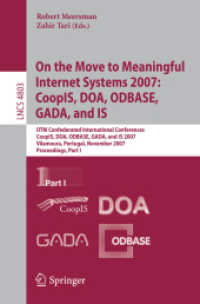Full Description
The essays collected in this book were delivered at the XLII Spring Symposium of Byzantine Studies, held in London in 2009 to accompany the exhibition Byzantium 330-1453, at the Royal Academy. The exhibition was one of the most ambitious and complex exhibitions ever mounted at the Royal Academy, as well as one of the most popular, and the overall aim of the book is to reflect on the exhibition of Byzantine art, both as an academic and popular exercise, and through the choice and discussion of individual objects. Exhibitions present a very different picture of Byzantium and its culture from works of history. The choices of object for display, their arrangement, and the underlying aims of exhibition curators and designers mean that every exhibition presents a different picture of Byzantium. Particular emphases can be placed, whether on everyday life or high court culture; Constantinople or the provinces; or claims of continuity or change over the Byzantine millennium. The essays explore aspects of the image of Byzantium that results from these choices. Given the enormous popularity of exhibitions of Byzantine objects (continued after the completion of this volume by exhibitions in Paris, Bonn and Istanbul), art has become one of the most popular and accessible means of popularizing Byzantium to a wide public audience. Hitherto there has been no general consideration of either the historiography of Byzantine exhibitions or the ways in which they have been set up to present different aspects of Byzantine culture to an academic and general public. The essays are divided into 3 sections: Exhibiting Byzantium sets the 2009 exhibition into the context of other exhibitions of Byzantine art and considers the issues involved in curating and viewing such major collections of medieval art; Object Lessons offers a set of studies of individual objects that were in the exhibition; Byzantium through its Art moves to consider Byzantine art more widely, thinking about the different ways in which objects can be used to study Byzantine culture and society. These are preceded by an introduction by the editors which sets the volume in context.
Contents
Contents: Introduction: Byzantium through its art, Liz James and Anthony Eastmond; Part I Exhibiting Byzantium: Learning lessons: from the Mother of God to Byzantium, Maria Vassilki; 'Of what is past, or passing, or to come', Robin Cormack; Two scenes from the prehistory of the Byzantine blockbuster, John Hanson; Exhibiting Byzantium: Edinburgh 1958 and London 2008, Rowena Loverance. Part II Object Lessons: Gospel decoration and its relation to artistic and doctrinal trends of the Middle-Byzantine period: a study with reference to the Marciana book covers, Niki J. Tsironis; The stepmum and the servant: the stepson and the sacred vessel, Cecily Hennessy; The Vienna 'empress' ivory and its companion in Florence: crowned in different glories?, Eileen Rubery; Representing decline and fall: 19th-century responses to the Asclepius-Hygieia and Clementinus ivory diptychs, Helen Rufus Ward; The complexity of the iconography of the bilateral icon with the Virgin Hodegetria and the Man of Sorrows, Kastoria, Teodora Burnand; The last wonderful thing: the icon of the Heavenly Ladder on Mount Sinai. Elena Ene D-Vasilescu; The date of two icons from Sinai, Georgi R. Parpulov; The Nestorian Discos in the light of apocryphal texts and artefacts, Vera Zalesskaya. Part III Byzantium Through its Art: From centre to periphery and beyond: the diffusion of models in late Antique metalware, Anastasia Drandaki; Textiles as text, Anna Muthesius; Some thoughts on Greco-Venetian artistic interactions in the 14th and early-15th centuries, Michele Bacci; Women at tombs: narrative, theatricality, and the contemplative mode, Robert Ousterhout; Show and tell, Leslie Brubaker; The idea of likeness in Byzantium, Anthony Cutler; Mary's parents in homilies before and after James Kokkinobaphos, Eirini Panou; Constantine's city: Constantine the Rhodian and the beauty of Constantinople, Marc D. Lauxtermann. Part IV Exhibiting Byzantium Reviewed: Seeing Byzantium: a personal response, Averil Ca








